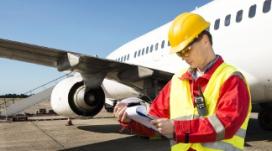FAA Releases New Generation of Safety Software
The Federal Aviation Administration (FAA) has an army of more than six thousand inspectors and safety professionals who evaluate facilities and equipment, assess air carrier operations, and make sure that air crews are certified and trained.
For more than three decades, FAA has used inspection models, which provide a roadmap for the inspection process, and software to ensure that inspectors keep asking operators and repair facilities the right questions.
| “Safety starts, I would argue, on the ground." - Edward Howerter, Volpe engineer who helped develop SAS. |
FAA recently released the next generation of safety management software, called Safety Assurance Systems (SAS). SAS expands FAA’s safety reach to include major carriers, which have always been in FAA’s safety focus, along with small airlines and maintenance facilities. SAS also fortifies FAA’s national framework for safety assurance, one of the four pillars of the Safety Management System for civil aviation in the U.S.
Safety Starts on the Ground
“FAA expects repair and maintenance stations to follow approved procedures—to only do work they are approved to do, to have clear lines of authority—and it’s all about safety,” said Edward Howerter, a Volpe engineer who developed SAS with Volpe IT specialist Edwin Tait. “Safety starts, I would argue, on the ground.”
Volpe helps FAA deal with the entire lifecycle of the agency’s safety systems—from concept to development, through analysis, testing, and release. Howerter and Tait’s team collaborated with numerous FAA subject matter experts to create SAS.
“Building a safety system is about dealing with concepts, but it’s also about dealing with details,” Howerter said. “One little character that’s off in a piece of software can make that program not work. So success, when dealing with a large complex system, is about dealing with details in a documented way and getting the review and testing processes in place.”
How SAS Works
Inspectors approach carriers and maintenance facilities with dozens of questions. When FAA combines the answers to those questions with thousands of other responses, a complete safety picture of America’s aviation landscape appears. Because SAS goes beyond the major carriers to include small carriers and maintenance facilities, this complete safety picture will let FAA better identify and mitigate specific risks.
SAS also provides FAA a more nuanced understanding of safety. With SAS, inspectors take questionnaires to the field that are specifically tailored to the air operator or facility being inspected.
For example, instead of a standard 35-question form, SAS gives inspectors an improved ability to analyze past information about air operators and maintenance facilities and target their questions toward safety areas that need the most attention. SAS questions also let inspectors record a gradation of responses: instead of a simple "Yes" or "No," inspectors can use a descriptive scale so that shades of gray emerge.
Safety Systems that Talk
SAS communicates with more than a half-dozen other safety systems in order to compile information for inspectors and it will also provide data that impacts the FAA workforce itself.
One of those systems is called ASTARS—the FAA Office of Aviation Safety Staffing Tool and Reporting System. ASTARS forecasts where and how many inspectors are needed for adequate safety oversight of the commercial skies, letting FAA make the most out of tight budgets.
At the end, all the performance models and software that support inspections make sure that the two million daily travelers enplaning in the United States arrive at their final destinations safely.
“The goal is for safety to keep getting better and better,” Howerter said. “We’re talking about more than five thousand air operators, nearly six thousand air agencies, a couple hundred thousand aircraft, and hundreds of millions of passenger miles. It is a significant oversight responsibility for the FAA and every safety improvement adds up.”

